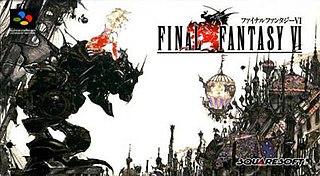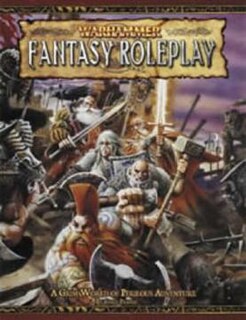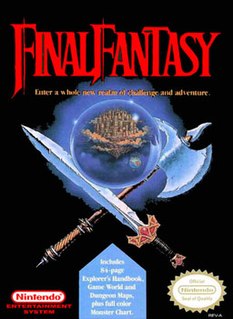Final Fantasy is a Japanese science fantasy media franchise created by Hironobu Sakaguchi, and developed and owned by Square Enix. The franchise centers on a series of fantasy and science fantasy role-playing video games (RPGs/JRPGs). The first game in the series was released in 1987, with 14 other main-numbered entries being released since then. The franchise has since branched into other video game genres such as tactical role-playing, action role-playing, massively multiplayer online role-playing, racing, third-person shooter, fighting, and rhythm, as well as branching into other media, including CGI films, anime, manga, and novels.

Might and Magic is a series of role-playing video games from New World Computing, which in 1996 became a subsidiary of The 3DO Company. The producer of the series was Jon Van Caneghem.

RuneQuest is a fantasy role-playing game first published in 1978 by Chaosium, created by Steve Perrin and set in Greg Stafford's mythical world of Glorantha. RuneQuest is notable for its system, designed around percentile dice and with an early implementation of skill rules, which became the basis of numerous other games. There have been several editions of the game.
Forgotten Realms is a campaign setting for the Dungeons & Dragons (D&D) fantasy role-playing game. Commonly referred to by players and game designers alike as "The Realms", it was created by game designer Ed Greenwood around 1967 as a setting for his childhood stories. Several years later, Greenwood brought the setting to the D&D game as a series of magazine articles, and the first Realms game products were released in 1987. Role-playing game products have been produced for the setting ever since, as have various licensed products including novels, role-playing video game adaptations, and comic books. The Forgotten Realms is one of the most popular D&D settings, largely due to the success of novels by authors such as R. A. Salvatore and numerous role-playing video games, including Pool of Radiance (1988), Eye of the Beholder (1991), Baldur's Gate (1998), Icewind Dale (2000) and Neverwinter Nights (2002).

Final Fantasy IV, known as Final Fantasy II for its initial North American release, is a role-playing video game developed and published by Square for the Super Nintendo Entertainment System. Released in 1991, it is the fourth main installment of the Final Fantasy series. The game's story follows Cecil, a dark knight, as he tries to prevent the sorcerer Golbez from seizing powerful crystals and destroying the world. He is joined on this quest by a frequently changing group of allies. Final Fantasy IV introduced innovations that became staples of the Final Fantasy series and role-playing games in general. Its "Active Time Battle" system was used in five subsequent Final Fantasy games, and unlike prior games in the series, IV gave each character their own unchangeable character class.

Final Fantasy VI, also known as Final Fantasy III from its marketing for initial North American release in 1994, is a role-playing video game developed and published by Japanese company Square for the Super Nintendo Entertainment System. Final Fantasy VI, being the sixth game in the series proper, was the first to be directed by someone other than producer and series creator Hironobu Sakaguchi; the role was filled instead by Yoshinori Kitase and Hiroyuki Ito. Yoshitaka Amano, long-time collaborator to the Final Fantasy series, returned as the character designer and contributed widely to visual concept design, while series-regular, composer Nobuo Uematsu, wrote the game's score, which has been released on several soundtrack albums. Set in a fantasy world with a technology level equivalent to that of the Second Industrial Revolution, the game's story follows an expanding cast that includes fourteen permanent playable characters. The drama includes and extends past depicting a rebellion against an evil military dictatorship, pursuit of a magical arms-race, use of chemical weapons in warfare, depiction of violent, apocalyptic confrontations with Divinities, several personal redemption arcs, teenage pregnancy, and the continuous renewal of hope and life itself.

Final Fantasy VII is a 1997 role-playing video game developed by Square for the PlayStation console. It is the seventh main installment in the Final Fantasy series. Published in Japan by Square, it was released in other regions by Sony Computer Entertainment and became the first in the main series to see a PAL release. The game's story follows Cloud Strife, a mercenary who joins an eco-terrorist organization to stop a world-controlling megacorporation from using the planet's life essence as an energy source. Events send Cloud and his allies in pursuit of Sephiroth, a superhuman intent on destroying their planet. During the journey, Cloud builds close friendships with his party members, including Aerith Gainsborough, who holds the secret to saving their world.

Final Fantasy V is a medieval-fantasy role-playing video game developed and published by Square in 1992 as a part of the Final Fantasy series. The game first appeared only in Japan on Nintendo's Super Famicom. It has been ported with minor differences to Sony's PlayStation and Nintendo's Game Boy Advance. An original video animation produced in 1994 called Final Fantasy: Legend of the Crystals serves as a sequel to the events depicted in the game. It was released for the PlayStation Network on April 6, 2011, in Japan. An enhanced port of the game, with new high-resolution graphics and a touch-based interface, was released for iPhone and iPad on March 28, 2013, and for Android on September 25, 2013.

Talisman: The Magical Quest Game is a fantasy-themed adventure board game for two to six players, originally designed and produced by Games Workshop. From 2008 to 2017 Fantasy Flight Games produced Talisman under license from Games Workshop.

Pool of Radiance is a role-playing video game developed and published by Strategic Simulations, Inc (SSI) in 1988. It was the first adaptation of TSR's Advanced Dungeons & Dragons (AD&D) fantasy role-playing game for home computers, becoming the first episode in a four-part series of D&D computer adventure games. The other games in the "Gold Box" series used the game engine pioneered in Pool of Radiance, as did later D&D titles such as the Neverwinter Nights online game. Pool of Radiance takes place in the Forgotten Realms fantasy setting, with the action centered in and around the port city of Phlan.

Margaret Edith Weis is an American fantasy and science fiction writer and author of dozens of novels and short stories. Along with Tracy Hickman, Weis is one of the original creators of the Dragonlance game world.
The flexibility of the Dungeons & Dragons (D&D) game rules means that Dungeon Masters (DM) are free to create their own fantasy campaign settings. For those who wanted a pre-packaged setting in which to play, TSR, Wizards of the Coast (WotC), and other publishers have created many settings in which D&D games can be based; of these, the Forgotten Realms, an epic fantasy world, has been one of the most successful and critically acclaimed settings. Many campaign settings include standard sword and sorcery environments, while others borrow Oriental, Central American, swashbuckling, horror and even space-travel themes.
The Dungeons & Dragons (D&D) fantasy role-playing game has spawned many related products, including magazines, films and video games.

Science fiction and fantasy in Poland dates to the late 18th century. During the later years of the People's Republic of Poland, social science fiction was a very popular genre of science fiction. Afterwards, many others gained prominence. Currently there are many science fiction writers in Poland. Internationally, the best known Polish science fiction writer is Stanisław Lem. As elsewhere, Polish science fiction is closely related to the genres of fantasy, horror and others. Although many English language writers have been translated into Polish, relatively little Polish language science fiction has been translated into English.

Warhammer Fantasy Roleplay or Warhammer Fantasy Role-Play is a role-playing game set in the Warhammer Fantasy setting, published by Games Workshop or its licensees.

A tabletop role-playing game is a form of role-playing game (RPG) in which the participants describe their characters' actions through speech. Participants determine the actions of their characters based on their characterization, and the actions succeed or fail according to a set formal system of rules and guidelines. Within the rules, players have the freedom to improvise; their choices shape the direction and outcome of the game.
Eastern role-playing video games (RPGs) are RPGs developed in East Asia. Most Eastern RPGs are Japanese role-playing video games (JRPGs), developed in Japan. RPGs are also developed in South Korea and in China.

Final Fantasy is a fantasy role-playing video game developed and published by Square in 1987. It is the first game in Square's Final Fantasy series, created by Hironobu Sakaguchi. Originally released for the NES, Final Fantasy was remade for several video game consoles and is frequently packaged with Final Fantasy II in video game collections. The story follows four youths called the Light Warriors, who each carry one of their world's four elemental orbs which have been darkened by the four Elemental Fiends. Together, they quest to defeat these evil forces, restore light to the orbs, and save their world.

Shadowrun is a science fantasy tabletop role-playing game set in a near-future fictional universe in which cybernetics, magic and fantasy creatures co-exist. It combines genres of cyberpunk, urban fantasy and crime, with occasional elements of conspiracy, horror and detective fiction. From its inception in 1989, Shadowrun has remained among the most popular role-playing games. It has spawned a vast franchise that includes a series of novels, a collectible card game, two miniature-based tabletop wargames, and multiple video games.














